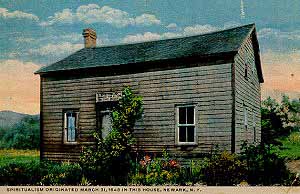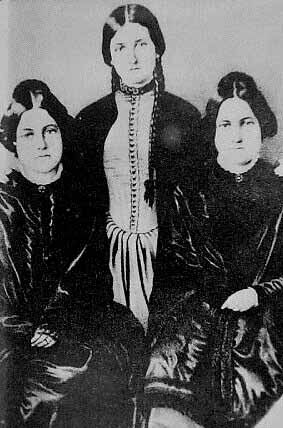
The Fox Sisters, Margaret, Kate and Leah
Spiritualism and Channeling!

 The Fox Sisters, Margaret, Kate and Leah |
Spiritualism and Channeling! |
 |
Pseudoscience does not progress, but it does change. It leaps from fad to fad; old crazes are forgotten as new crazes come in, or old, old crazes are revived. One of the longest lasting pseudoscientific fads, dominating for almost 70 years from the mid-1850s to the mid-1920s, has since the late 1970s experienced a major resurgence: Spiritualism. In the history of pseudoscience, Spiritualism occupies a central position. In the 19th century, Spiritualism spawned an important offshoot, the synthetic religion Theosophy, which evolved into the “New Age” movement, but has also had a heavy influence on 20th and 21st century pseudoscience and pseudoscientists, from Edgar Cayce to Charles Berlitz, from George Adamski and Billy Meier to Erich Von Däniken. Even more important, Spiritualism, as it faded for a while in the early 20th century, gave birth to all the familiar folderol about “psychics,” and “psychic phenomena,” including extrasensory perception, telepathy, psychokinesis, psychic detectives, and psychic “supermen.” Key figures in 20th century pseudoscience, like Peter Hurkos, Ninel Kulagina and Uri Geller, are direct descendants of the great figures of Spiritualism a century before, particularly Daniel Home and Henry Slade.
The 19th century’s first popular pseudoscientific fad was Mesmerism, or hypnotism as it later came to be called. Most people encountered Mesmerism in the form of a stage act in which a mesmerist “cast a spell” on local townspeople, getting them to act sort of crazy, mainly— to imitate a chicken, play on a broom as if it were a banjo, etc.— but sometimes to demonstrate supernatural powers such as thought-reading. By 1850 interest in Mesmerism had largely faded— you can watch only a few people imitate chickens before it gets to be a bore— and the stage was set for something new. It came, from the consequences of a prank played by two girls, ages 8 and 6-1/2, on their superstitious and somewhat dimwitted mother. The two girls, Margaret and Katherine Fox, teased their parents by making noises in their attic bedroom at night in hopes of getting their mother, who frequently spoke credulously of ghosts, to proclaim the house haunted. As both Margaret and Kate later confessed, independently, they were sure their mother would finally catch on to the prank when they produced the mystery noises (“raps”) with their mother watching, as the girls lay in their bed under quilts in the attic. Instead, Mom ran out to get neighbors to witness the “miracle” of spirits of the dead communicating with the living via spirit raps. Thus, on March 31, 1848, was Spiritualism born! It quickly grew into a lusty, vigorous child! [The concept of mediumship itself can be traced all the way back to a charlatan named Edward Kelley (1555-1597); since the concept of a “spirit” was not well-established this early in the Reniassance, Kelley clamed to be communicating with angels.]
The method of communication inherited from the Fox sisters was incredibly laborious, as an anonymous humorist pointed out in 1854 in depicting Wagstaff, a “writing, tipping, knocking, rapping, and speaking mejum.” Sitters of the medium recited the alphabet while the spirits rapped softly or vigorously to indicate a hit:
“A?” (Silence) “B?” (Silence) “C?” (Silence) “D?” (Silence) “E. F. J?” Rap, rap, rap! “O?” Rap, rap, rap! “Well, let the ‘seph’ go, it’s Joseph, ain’t it?” Rap, rap, rap! “A, B, C, D, E, F, G, H, I, J, K, L, M, N, O, P”— Rap, rap, rap!! “P, says I .. what’s the uset uv wastin’ time? It’s Joseph Pipkins, ain’t it?” Rap, rap, rap!!!!
From loud raps produced near the
center of a table, mediums went on to cause the table to tip and turn
and even float in the air, still a laborious way of spelling out the
spirit messages. The spirits contacted by “Dr.” Henry Slade, more
reasonable, wrote in a clear hand on a school slate with chalk or a
slate pencil, establishing the new look of Spiritualism for 1860. By
this time the full spirit séance had been born. In a semi- or
totally-darkened room, customers held hands around a table— usually
holding the
medium’s hands, too,
in what was called “control.” The medium went into a “trance” and
eventually spoke in a strange voice… the spirits were speaking through
her! She could then be questioned directly, omitting the laborious
spelling out or writing out of answers. One problem with this
conversational approach was that
sitters would perhaps wonder why the spirit of Uncle Charles did not
speak in
Uncle Charles’ distinctive voice, or at least in his distinctive style.
The solution was the spirit guide— the only spirit the medium could
communicate with directly, the only spirit who could speak through the
medium. The guide would be sent to find
Uncle Charles in the spirit world, and would relay questions to Charles
and his answers. Any failure of Uncle Charles’ relayed answers to make
sense to the relatives was thus conveniently explained by the ignorance,
confusion
or puckishness of the guide, who was often said to be the spirit of
a small child. [Spirit guides were somewhat promiscuous;
pirate John King showed up as the personal guide of nearly a dozen
different mediums, after having been invented by music-hall performers
the Davenport Brothers!]
As proof the medium was in contact with the spirits, various “phenomena” or “physical demonstrations” were produced. As the room was usually totally dark these phenomena were limited to sounds, odors, luminosity, and the like. Raps sounded, tables tipped, musical instruments played by themselves, ghostly cold winds blew down the necks of the sitters, objects appeared in midair and fell to the tabletop, strange incenses and perfumes were smelled…. Following the lead of music hall performers Ira and William Davenport, some mediums allowed themselves to be tied hand and foot with rope before exhibiting their phenomena. Thus was born, in actual fact, the escape act that magicians like Houdini later made a headline feat. But the medium did not observably escape. After the séance she could be found still apparently securely tied, still in a trance, whatever that is.
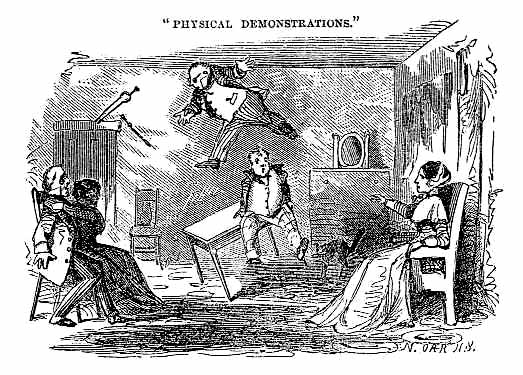 |
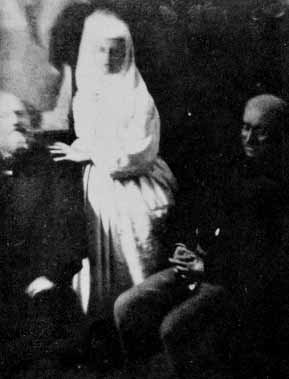 Materialized spirit Katie King! |
Each medium had his or her own trademark effects, and these tended to become more and more spectacular as the century and competition wore on. Daniel Home “materialized” tiny hands, which appeared at the edge of the table— about as far as Home’s feet could reach!— and which the séance sitters could even touch. By the early 1870s, mediums were undertaking risky “full figure materializations.” While the medium retired to another room to “go into a trance,” all the lights were turned out or far down, and the séance sitters sang hymns until they were half asleep… and suddenly, the very form and figure of the departed loved one was dimly seen to enter the room… always wearing a concealing robe, a hood or a helmet, and often even a false beard! These materializations invariably proved to be the most dangerous of all Spiritualist phenomena. For every single bound or controlled medium who was caught releasing her hands or feet to work a trumpet or a tambourine, several were caught playing the part of the “full figure materialization.” The temptation of members of the audience (or skeptical journalists and professors) to reach out and grab the spirit proved almost irresistible, and every medium who performed such materializations was publicly exposed at one time or another when a skeptic or an overenthusiastic believer accidentally or on purpose jerked off the spirit’s robe or hood or wig or beard, to reveal, usually, the medium herself, but always a very much alive and unspiritual person in costume.
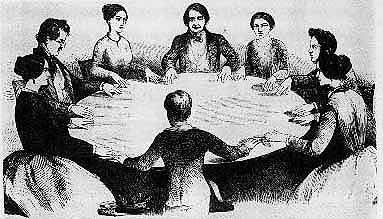 |
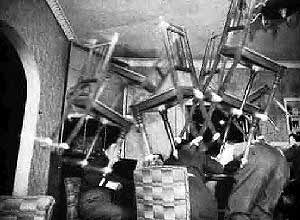 |
One of the most interesting “phenomena” exhibited during the late 19th-Century heyday of the séance was “the Direct Voice.” The medium sat in plain sight, motionless, while the invisible spirit spoke from thin air in a distinctive, appropriately spooky voice! Mediums who worked with assistants achieved this effect simply by having an assistant, out of sight but acoustically near at hand, speak through a long, thin megaphone. However, many mediums preferred to work alone, and often performed at the homes of hosts; they created the “Direct Voice” phenomenon via what was soon to be known as ventriloquism, and indeed students of the history of the ventriloqual art have studied 19th Century reports of such séances very closely!
Almost every prominent medium was caught in one or more acts of gross trickery. In the Fall of 1888, Margaret and Kate Fox told their full story, confessing to every detail of their original and later trickery, and giving a public demonstration. None of these well-publicized exposures had any effect on believers, but the scandals and the preposterous claims kept scientists as far away from Spiritualism as they could get, especially after physicist William Crookes (1832-1919) and his girlfriend, medium Florence Cooke, were involved in a remarkable scandal that is still being studied by historians of the period. Crookes later renounced totally all interest in Spiritualism, and in the latter part of his life did reputable— indeed, excellent— work in physics. Other scientists who investigated without getting emotionally involved— including Michael Faraday, the greatest experimental physicist of the 19th century— invariably found nothing but trickery and self-deception underlying any of the phenomena of Spiritualism.
Spiritualism has proved to be amazingly flexible and adaptive over the years, whilst still retaining all its traditional trappings. For example, in the early 1950s, contacting the occupants of flying saucers became all the rage. While pioneering “contactees” like George Adamski had to summon down saucer pilots to a landing, directly via telepathy, it quickly became much more common to summon up the Space Brothers in very conventional séances— despite the fact that the Space Brothers were living, hale and hearty, and blithely flying about in their saucers at the time!
The most typical “researchers” in Spiritualism tended to have no scientific background or expertise at all, like the founders of England’s Society for Psychical Research, who were trained in classics and music. The interest of such societies and “researchers” was shifting by 1890 from Spiritualism to psychic phenomena in general. The evolution came about as Palladino levitated tables and caused impressions to appear in modelling clay; “Margery” extruded what looked like a hand crudely carved from liver from her navel and had spirits dip their hands into liquid wax; Slade caused the spirits to write with a regular piece of chalk on a regular slate; and, other mediums had the spirits “possess” their hands and write with a regular pen on regular paper! In fact, no two mediums did the same “act.” How then could the totally random range of phenomena all be explained by the same process, conscious actions of the spirits? The obvious explanation, that each medium had his or her own favorite repertoire of personal séance tricks, was rejected by the “researchers,” since that would leave them looking like fools. The pseudosavants thus put forward an alternate conclusion: that what one is seeing in a séance has nothing to do with spirits, but rather is a demonstration of the supernatural mental powers of the medium herself. The information revealed about dead relatives of the sitters thus came not from spirits, but by the medium unconsciously reading the minds of the sitters! (It actually usually came from cold or hot reading of the sitters by the medium before the séance). Mediums, in addition to telepathy, were supposed to exhibit clairvoyance (the ability to see without the use of vision), precognition (the ability to be aware of events before they happen), astral projection (the ability to “project” one’s awareness to spots arbitrarily distant from one’s entranced body), and psychokinesis (the ability to move objects by the power of the mind alone). The uncritical marveling at and cataloging of mediumistic stunts thus evolved into the uncritical marveling at and cataloging of supposed mysterious powers of the human mind, and the societies originally formed to “investigate” mediums and séances evolved quickly, by 1890–1900, into societies to “investigate” psychical abilities in humans. The tricks done by the psychics under investigation were generally exactly the same as the tricks earlier done by mediums, but they were generally done under different conditions (no darkness, no hand-holding, no tying up the psychic with ropes) that made some tricks more difficult and others much easier to get away with. As a result, the famous psychics of the 20th century, such as Uri Geller and Ninel Kulagina, are very direct heirs of the selected séance repertoire of the famous mediums of the 19th and early 20th century.
It didn't seem to bother “psychic researchers” of the 1890s or the 1930s that doing miracles with the help of the spirits and doing miracles with the aid of psychic powers are mutually exclusive activities. Spirit mediums took instant advantage of this mindlessness by redefining themselves as “psychics,” while leaving their original credentials as “mediums” intact! This redefinition has persisted to the present day, so that self-proclaimed “psychic supermen (or women)” have no trouble summoning up spirits if that's what the paying customer wants, while spirit mediums have no difficulty in performing “superpsychic feats” that depend on the amazing and undefinable powers of the human mind, not invisible spiritual aid.
How very direct— if completely illogical— the connection is between Spiritualism and ESP (Extrasensory perception, whatever that is) research can be seen from the early careers of the two best-known 20th century ESP researchers, Joseph Banks Rhine and Dr. Samuel G. Soal. Rhine and his wife Louisa were trained in botany, but after hearing an enthusiastic 1925 talk on Spiritualism by novelist Sir Arthur Conan Doyle, they dove with religious fervor into psychic studies that evolved gradually into the notoriously inept ESP experiments done at Duke University in the 1930s and 1940s. Similarly, Soal’s interest in ESP began with his meeting with a Spiritualist medium in 1922. During the 1930s he was a sharp critic of the fumbling, fraud-ridden experiments of Joseph Rhine, but Soal’s own experiments, conducted in the 1940s and 1950s, are equally flawed, and the surviving records of these experiments also indicate that Soal himself perpetrated a deliberate fraud in recording the data to indicate the presence of more correct guesses than the subjects actually made. Both Soal and Rhine, and most later so-called parapsychologists who tout dramatic “above-chance results” tended to be motivated not by a spirit of scientific inquiry, but rather by a sort of religious fervor… the “experiments” were done only to provide bogus validation of pre-existing beliefs. Rhine was quoted as saying that the primary goal of all his work was to “prove the existence and immortality of the human soul.” A lofty goal indeed, but one science is unlikely ever to achieve, for several excellent reasons! The religious fervor we have mentioned traces back directly to Spiritualism, which survived in the U.S. and England mainly as a branch of organized religion, during most of the 20th century. Spiritualist churches in areas heavily populated by the retired, such as Florida and Arizona, still send thousands of believers annually to summer Spiritualist camps in Indiana and Pennsylvania, where the faithful attend very traditional séances, and the staff mediums take in millions of dollars per season. But the rise of TV and of media advertising has given spiritualism a whole new look since the late 1960s. Under the new name of “channeling,” the basic appeal of Spiritualism has been retreaded for the latter half of the 20th century with spectacular success, and shows no signs of dying away as the 21st century gets well underway. Modern mediums such as John Edward and James Van Praagh don't hold any séances or do any tricks, don't serve as the focus for any “phenomena.” Instead they use the standard cold-reading tricks perfected over centuries of professional fortune telling to dazzle audiences and customers with “inexplicable personal revelations” from dead relatives. In England, Derek Acorah has had similar success. You spend a lot of time with dead people, but, hey, it's a living!
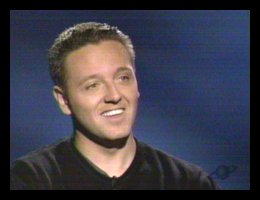 John Edward |
 Derek Acorah |
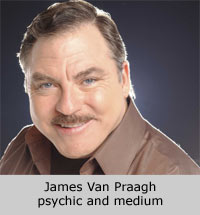 |
For further reading—
• Paranormality: Why We See What Isn't There, by Richard Wiseman, MacMillan, London, 2011, Ch. 5.Internet resources on Spiritualism:
Skeptic's Dictionary entry on Spiritualism. A typical manifestation of modern-day Spiritualism! The earliest Spiritualism-themed stage act was the Davenport Brothers. Here's a good on-line article about their feats and act.
Acknowledgments—
Dr. Rory Coker, Professor of Physics at the University of Texas at Austin, is the author of this fact sheet. The International Cultic Studies Association, a professional research and educational organization concerned about the harmful effects of cultic and related involvements, prints and helps distribute these fact sheets. Because these act sheets seek to stimulate critical thinking, rather than advance a particular point of view, opinions expressed are those of the authors. These fact sheets may be copied for educational purposes, but they may not be reproduced for resale.
